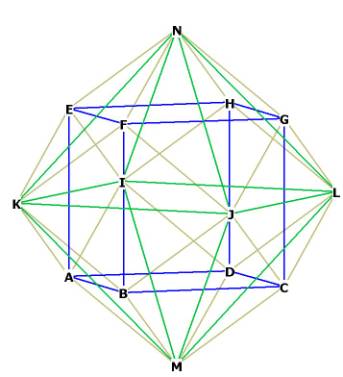|
(2019
midterm assignment) Model Midterm answers 2019 (Index) Essay 1: Compare, contrast, and evaluate Narratives of the Future |
 |
Sage Butler
Examining the Narratives of the Future
In literature of the future, there are
three primary narratives: apocalypse, evolution, and alternative. Apocalyptic
literature takes place immediately preceding, during, or after the collapse of a
civilization. Evolution narratives describe changes that have occurred in the
characters’ world and to humankind, and explore the growth and/or regression
that may have taken place.
Alternative futures are based on other “possible” worlds, which may have come
about if certain events did or did not take place, or parallel worlds, which
share many similar and very different qualities with our own.
As a whole, these different narratives help me better understand that,
though narratives of the future may have different origins and paths, they show
what could be if society continues down the path we are on, and the significance
that a single event may have on our future as a whole.
Differentiating between apocalyptic and
evolutionary narratives is more attainable when analyzing the different styles,
signs, symbols, and metaphors that are typically present in the literature. In
apocalypse narratives, the event that changes society is typically dramatic and
happens quickly—in the Book of Revelation, Jesus suddenly releases hell on
Earth, with plagues, rivers of blood, and beasts attacking the world’s
population. Evolution narratives typically is more gradual, such as the economic
decline and destruction of the climate in Parable of the Sower, though it
is a blend of apocalyptic and evolutionary narratives. Evolutionary visions have
a larger time scale, as well, according to “Future Narratives Compared” on the
course website.
There is also a heavier presence of symbolism and signs
in apocalyptic narratives, such as the numbers “666” or “7” throughout the
Bible, and God being change is repeated throughout Parable. In
evolutionary narratives, survival is also emphasized more—in “Stone Lives,” the
titular character thinks to himself that “survival is his main—his
only—concern.” This idea is also present in Katie Morin’s “Destiny Defined:
Analyzing Narratives of the Future,” when she says that evolving is necessary
for survival in these narratives. However, in apocalyptic literature, purity is
a common theme: clearing the Earth of “impure” beings is one major concept, even
in popular apocalyptic movies, such as
Bird Box (2018).
Apocalyptic narratives appeal to many
people as literature and culturally because there is often rich symbolism and
signs, which helps connect ideas and gives readers the feeling that they can
prevent the apocalypse from impacting them as dramatically—often through
physical, mental, and, often most importantly, spiritual preparation. However,
individuals are often written as unable to change the reality of the world as a
whole, and can typically only influence their own wellbeing. In apocalyptic
narratives, authors typically write about the decline of humanity, which
requires an apocalypse to “cleanse” our world, leading to progress. The downside
of this style of literature is that apocalypses are typically written as
unpreventable, which gives readers a sense of helplessness.
Evolutionary narratives often do the opposite—since
change is slow, readers feel that they can stop or at least be well-prepared if
that situation comes to light, since these narratives often take place in a
future that could happen if our society continues to go down the path it is on.
However, there is often less control felt in those situations about how to live
their lives—usually, characters have to adapt to their environment and hope that
they are the fittest, and they cannot change the situation as a whole, just
their own fate. Evolutionary literature can represent either decline or
progress, depending on the authors’ perspective. This is especially noticeable
in the Time Machine, as it can be debated that the world has progressed,
since there is less need for wit or strength. On the other hand, it can also be
argued that humanity has declined, either by looking at the Eloi, who have grown
to be fragile, inattentive, and fearful, or by examining the Morlocks, who live
underground and feed on the Eloi.
While apocalyptic and evolutionary narratives differ in
many ways, they do have similar structures and features—one example of such is
that there is only one reality, which, despite what many hope, is often
unavoidable. Alternative future narratives, however, are centered around the
many possibilities of what reality could be, and individuals often have more
importance in these stories, as choices are emphasized to be largely impactful.
In “Better Be Ready ‘Bout Half Past Eight,” Byron realizes that his child can be
anything, which is an acceptance of alternative futures that was not present
during his earlier emphasis of his son only being male. Time is more complex in
alternative narratives: rather than being represented in a linear or cyclical
fashion over thousands to billions of years, these stories can take place
simultaneously, and time is more influenced by the one experiencing it. The
different realities are often depicted as parallel worlds, forking paths, or
mazes. One example of such was written in “Garden of Forking Paths,” when Albert
expresses Ts'ui Pên’s belief in "an infinite series of times, in a growing,
dizzying net of divergent, convergent and parallel times… Time forks perpetually
toward innumerable futures.”
Overall, the emphasis of possibilities and choice in
alternative narratives is a critical defining factor of the sub-genre. It
appeals to many readers because the idea of other possible realities is enticing
to those who wish their own reality would improve, and because of the basis of
the narrative is a complex scientific theory—being able to understand it can be
self-gratifying. Others may not enjoy this particular sub-genre for the same
reason: it can be difficult to accept the idea of alternative possibilities of
one’s own life, and the importance of choice can lead people having to face the
guilt that accompanies decisions they make, as they can no longer deny the
significance these choices may have. In the context of our culture, the values
expressed in alternative narratives are often less absolute than the ones that
are present in our reality. This can make these narratives even more difficult
to relate to for some, but enticing to others. As literature, it allows for
infinite possibilities, which is appealing to both writers and readers who want
to explore new concepts.
While “Narratives of the Future” often paints a specific image in one’s mind, it is a broad genre that encompasses various natures and scales of time, roles of individuals and humanity, and literary appeals. Depending on one’s purpose for reading, at least one of the narratives will be able to fulfill the need.
 |
 |
 |
